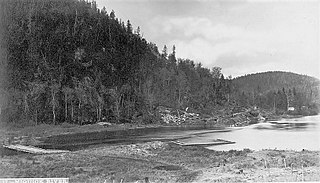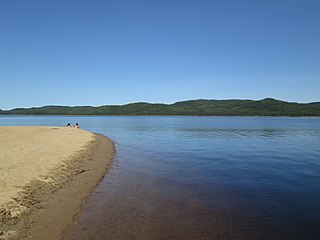Rivière-à-Pierre | |
|---|---|
 Aerial view of Rivière-à-Pierre | |
| Motto(s): Paix et fidélité (Peace and loyalty) | |
 Location within Portneuf RCM. | |
| Coordinates: 46°59′N72°11′W / 46.983°N 72.183°W [1] | |
| Country | |
| Province | |
| Region | Capitale-Nationale |
| RCM | Portneuf |
| Settled | 1880 |
| Constituted | October 11, 1897 |
| Government | |
| • Mayor | Danielle Ouellet |
| • Federal riding | Portneuf—Jacques-Cartier |
| • Prov. riding | Portneuf |
| Area | |
• Total | 535.10 km2 (206.60 sq mi) |
| • Land | 515.62 km2 (199.08 sq mi) |
| Population (2021) [3] | |
• Total | 625 |
| • Density | 1.2/km2 (3/sq mi) |
| • Pop 2016–2021 | |
| • Dwellings | 609 |
| Time zone | UTC−5 (EST) |
| • Summer (DST) | UTC−4 (EDT) |
| Postal code(s) | |
| Area code(s) | 418 and 581 |
| Highways | |
| Website | www |
Rivière-à-Pierre (French pronunciation: [ʁivjɛʁapjɛʁ] ) is a municipality of the Portneuf Regional County Municipality, in the administrative region of the Capitale-Nationale. This area of the Laurentian Mountains is part of the Batiscanie and has more than 200 lakes. The village of Rivière-à-Pierre was developed on each side of the river that bears its name. Rivière-à-Pierre is the second largest municipality in the Portneuf RCM in terms of area.
Contents
- History
- Demographics
- Attractions
- Multi-functional track
- Granite quarry
- Granite Interpretation Centre
- "Marmite" Fall
- Railway station
- Church and rectory
- Replica of the cross of Gaspé
- Government
- See also
- References
- External links

Rivière-à-Pierre is recognized as the gateway to the Portneuf Wildlife Reserve, bringing many visitors, campers, hikers, hunters and fishermen into this wilderness. Until 1968, many private clubs were active in this area. Its territory is sparsely populated and dotted with many lakes.
The Rivière-à-Pierre railway station, located in the village is served by Via Rail. [6] Many retirees and cottagers move to the areas around the lakes of the municipality during the summer. The resorts contribute significantly to the local economy.
Rivière-à-Pierre is recognized as the most important extraction center of architectural stones in Quebec. In Rivière-à-Pierre, many homes and public buildings include granite in their architecture: exterior walls, columns, sidewalks, driveway pavers, patios, stairs, galleries, etc. Stonemasons and stone engravers also use their talents to produce various accessories in granite: picnic tables, fences, poles, street numbers of houses, desks, benches, stands, ornaments, etc. In a village tour, visitors are often impressed by the architectural presence of granite.
The name "Rivière-à-Pierre" was recorded as of December 5, 1968 to the register of the "Commission de toponymie du Québec" (Toponymic Commission of Quebec). "As the riverbed Pierre (toponym used as Rivière-à-Pierre since at least 1829 by the surveyor Jean-Pierre Proulx) was once considered very rocky and it was their way through many crags, it seemed quite natural to assign this name, which has been transposed to a municipality in the Portneuf region in 1948." [7]
Is the name of the river connected to the toponym "Lac-à-Pierre" (lake of stones) at the head of the "Petite Rivière Batiscan" (North-East of the village of Rivière-à-Pierre) which flows through a succession of lakes up to the "rivière-à-Pierre": "Petit Lac Batiscan", Parke Lake and "Lac du coin"? In this region, rivers and lakes generally have a bed of stony nature.
The "Canton de Bois" (Township of Bois) originates from the Abbot Louis-Édouard Bois, bibliophile, who wrote an edition of the Jesuit Relations. [8] The "Municipalité of canton Bois" (Municipality of Township Bois) was incorporated in 1897 and adopted the name "Rivière-à-Pierre" in 1948. Railway station built on the edge of the railway line Garneau-Junction-Lac-Saint-Jean, already bore the name "Rivière-à-Pierre-Station".
















